Numerical Simulation of the Period 1971–2100 over the Mediterranean Area with a Regional Model, Scenario SRES-A1B
Abstract
:1. Introduction
2. Model and Data
2.1. The Regional Climate Model COSMO-CLM
- Non hydrostatic, full compressible hydro-thermodynamical equations in advection form;
- base state: Hydrostatic, at rest;
- prognostic variables: Horizontal and vertical Cartesian wind components, pressure perturbation, temperature, specific humidity, cloud water content. Optional: Cloud ice content, turbulent kinetic energy, specific water content of rain, snow and graupel;
- coordinate system: Generalized terrain following height coordinate with rotated geographical coordinates and user defined grid stretching in the vertical direction. Options for (i) base-state pressure based height coordinate; (ii) Gal Chen height coordinate; and (iii) exponential height coordinate (SLEVE) according to [16];
- grid structure—Arakawa C-grid, Lorenz vertical grid staggering;
- time integration: Time splitting between fast and slow modes (Leapfrog, Runge-Kutta);
- spatial discretization: 2° order accurate Finite Difference technique;
- parallelization: Domain Decomposition (MPI as message passing S/W);
- parameterizations: Subgrid-Scale Turbulence; Surface Layer Parameterization; Grid-Scale Clouds and Precipitation; Subgrid-Scale Clouds; Moist Convection; Shallow Convection; Radiation; Soil Model; Terrain and Surface Data.
2.2. Observational Dataset
3. Validation
3.1. Temperature
3.2. Precipitation
3.3. Total Cloud Cover
4. Climate Projections
5. Conclusions
Author Contributions
Conflicts of Interest
References
- Josey, S. Changes in the heat and fresh water forcing of the eastern Mediterranean and their influence on deep water formation. J. Geophys. Res. 2003, 108, 3237. [Google Scholar] [CrossRef]
- Giorgi, F.; Lionello, P. Climate change projections for the Mediterranean region. Glob. Planet. Chang. 2008, 63, 90–104. [Google Scholar] [CrossRef]
- Giorgi, F. Climate change Hot-spots. Geophys. Res. Lett. 2006, 33, L08707. [Google Scholar] [CrossRef]
- Intergovernmental Panel on Climate Change (IPCC). Managing the Risks of Extreme Events and Disasters to Advance Climate Change Adaptation; A Special Report of Working Groups I and II of the Intergovernmental Panel on Climate Change; Field, C.B., Barros, V., Stocker, T.F., Qin, D., Dokken, D.J., Ebi, K.L., Mastrandrea, M.D., Mach, K.J., Plattner, G.-K., Allen, S.K., et al., Eds.; Cambridge University Press: Cambridge, UK; New York, NY, USA, 2012. [Google Scholar]
- Anav, A.; Ruti, P.M.; Artale, V.; Valentini, R. Modelling the effects of land-cover changes on surface climate in the Mediter ranean region. Clim. Res. 2010, 41, 104. [Google Scholar] [CrossRef]
- Giorgi, F.; Jones, C.; Asrar, G.R. Addressing climate information needs at the regional level: The CORDEX framework. WMO Bull. 2009, 58, 175–183. [Google Scholar]
- Senatore, A.; Mendicino, G.; Smiatek, G.; Kunstmann, H. Regional climate change projections and hydrological impact analysis for a Mediterranean basin in Southern Italy. J. Hydrol. 2011, 399, 70–92. [Google Scholar] [CrossRef]
- Christensen, J.H.; Christensen, O.B. A summary of the PRUDENCE model projections of change in European climate by the end of this century. Clim. Chang. 2007, 81, 7–30. [Google Scholar] [CrossRef]
- Van Der Linden, P.; Mitchell, J. Ensembles: Climate Change and Its Impacts: Summary of Research and Results from the Ensembles Project; Met Office Hadley Centre: Exeter, UK, 2009; p. 160. [Google Scholar]
- Rockel, B.; Will, A.; Hense, A. The regional climate model cosmo-clm (cclm). Meteorol. Z. 2008, 17, 347–348. [Google Scholar] [CrossRef]
- Intergovernmental Panel on Climate Change (IPCC). Towards New Scenarios for Analysis of Emissions, Climate Change, Impacts, and Response Strategies; IPCC Expert Meeting Report; Intergovernmental Panel on Climate Change: Geneva, Switzerland, 2008. [Google Scholar]
- Ruti, P.; Somot, S.; Giorgi, F.; Dubois, C.; Flaounas, E.; Obermann, A.; Dell’Aquila, A.; Pisacane, G.; Harzallah, A.; Lombardi, E.; et al. Med-CORDEX Initiative for Mediterranean Climate Studies. Bull. Am. Meteorol. Soc. 2016, 97, 1187–1208. [Google Scholar] [CrossRef] [Green Version]
- Rockel, B.; Geyer, B. The performance of the regional climate model clm in different climate regions, based on example of precipitation. Meteorol. Z. 2008, 17, 487–498. [Google Scholar] [CrossRef]
- Steppeler, J.; Doms, G.; Schattler, U.; Bitzer, H.W.; Gassmann, A.; Damrath, U.; Gregoric, G. Meso-gamma scale forecasts using the nonhydrostatic model lm. Meteorol. Atmos. Phys. 2003, 82, 75–96. [Google Scholar] [CrossRef]
- Bohm, U.; Kucken, M.; Ahrens, A.; Block, A.; Hauffe, D.; Keuler, K.; Rockel, B.; Will, A. CLM the climate version of LM: Brief description and long term applications. COSMO Newslett. 2006, 6, 225–235. [Google Scholar]
- Schär, C.; Leuenberger, D.; Fuhrer, O.; Lüthi, D.; Girard, C. A New Terrain-Following Vertical Coordinate Formulation for Atmospheric Prediction Models. Mon. Weather. Rev. 2002, 130, 2459–2480. [Google Scholar] [CrossRef]
- Uppala, S.M.; Kallberg, P.W.; Simmons, A.J.; Andrae, U.; Da Costa Bechtold, V.; Fiorino, M.; Gibson, J.K.; Haseler, J.; Hernandez, A.; Kelly, G.A.; et al. The era-40 re-analysis. Q. J. R. Meteorol. Soc. 2006, 612, 2961–3012. [Google Scholar] [CrossRef]
- Gualdi, S.; Somot, S.; Li, L.; Artale, V.; Adani, M.; Bellucci, A.; Braun, A.; Calmanti, S.; Carillo, A.; Dell’Aquila, A.; et al. The CIRCE Simulations: Regional Climate Change Projections with Realistic Representation of the Mediterranean Sea. Bull. Am. Meteorol. Soc. 2013, 94, 65–81. [Google Scholar] [CrossRef] [Green Version]
- Haylock, M.R.; Hofstra, N.; Klein Tank, A.M.G.; Klok, E.J.; Jones, P.D.; New, M. A European daily high-resolution gridded data set of surface temperature and precipitation for 1950–2006. J. Geophys. Res. 2008, 113. [Google Scholar] [CrossRef]
- Dee, D.S.; Uppala, M.; Simmons, A.J.; Berrisford, P.; Poli, P.; Kobayashi, S.; Andrae, U.; Balmaseda, M.A.; Balsamo, G.; Bauer, P.; et al. The era-interim reanalysis: Configuration and performance of the data assimilation system. Q. J. R. Meteorol. Soc. 2011, 137, 553–597. [Google Scholar] [CrossRef]
- Haslinger, K.; Anders, I.; Hofstätter, M. Regional climate modelling over complex terrain: an evaluation study of COSMO-CLM hindcast model runs for the Greater Alpine Region. Clim. Dyn. 2012, 40, 511–529. [Google Scholar] [CrossRef]
- Boberg, F.; Christensen, J.H. Overestimation of Mediterranean summer temperature projections due to model deficiencies. Nat. Clim. Chang. 2012, 2, 433–436. [Google Scholar] [CrossRef]
- Jacob, D.; Bärring, L.; Christensen, O.B.; Christensen, J.H.; de Castro, M.; Déqué, M.; Giorgi, F.; Hagemann, S.; Hirschi, M.; Jones, R.; et al. Aninter-comparison of regional climate models for Europe: Model performance in Present-Day Climate. Clim. Chang. 2007, 81, 31–52. [Google Scholar] [CrossRef]
- Kotlarski, S.; Kriegsmann, A.; Martin, E.; van Meijgaard, E.; Moseley, C.; Pfeifer, S.; Preuschmann, S.; Radermacher, C.; Radtke, K.; Rechid, D.; et al. EURO-CORDEX: New high-resolution climate change projections for European impact research. Reg. Environ. Chang. 2014, 14, 563–578. [Google Scholar]
- Bucchignani, E.; Sanna, A.; Gualdi, S.; Castellari, S.; Schiano, P. Simulation of the climate of the XX century in the Alpine space. Nat. Hazards 2011, 67, 981–990. [Google Scholar] [CrossRef]
- Rauscher, S.A.; Coppola, E.; Piani, C.; Giorgi, F. Resolution effects on regional climate model simulations of seasonal precipitation over Europe. Clim. Dyn. 2009, 35, 685–711. [Google Scholar] [CrossRef]
- Cardoso, R.M.; Soares, P.M.; Miranda, P.M.; Belo-Pereira, M. A WRF high resolution simulation of Iberian mean and extreme precipitation climate. Int. J. Climatol. 2013, 33, 2591–2608. [Google Scholar] [CrossRef]
- Roesch, A.; Jaeger, E.B.; Luthi, D.; Seneviratne, S.I. Analysis of CCLM model biases in relation to intra-ensemble model variability. Meteorol. Z. 2008, 17, 369–382. [Google Scholar] [CrossRef]
- Jaeger, E.B.; Anders, I.; Luthi, D.; Rockel, B.; Schar, C.; Senevratne, S.I. Analysis of ERA40-driven CLM simulations for Europe. Meteorol. Z. 2008, 17, 349–367. [Google Scholar] [CrossRef]
- Moss, R.; Edmonds, J.; Hibbard, K.; Manning, M.; Rose, S.; van Vuuren, D.P.; Carter, T.; Emori, S.; Kainuma, M.; Kram, T.; et al. The next generation of scenarios for climate change research and assessment. Nature 2010, 463, 747–756. [Google Scholar] [CrossRef] [PubMed]
- Zittis, G.; Hadjinicolaou, P.; Fnais, M.; Lelieveld, J. Projected changes in heat wave characteristics in the eastern Mediterranean and the Middle East. Reg. Environ. Chang. 2016, 16, 1863–1876. [Google Scholar] [CrossRef]
- Coppola, E.; Giorgi, F. An assessment of temperature and precipitation change projections over Italy from recent global and regional climate model simulations. Int. J. Climatol. 2010, 30, 11–32. [Google Scholar] [CrossRef]
- Bucchignani, E.; Montesarchio, M.; Zollo, A.L.; Mercogliano, P. High-resolution climate simulations with COSMO-CLM over Italy: performance evaluation and climate projections for the 21st century. Int. J. Clim. 2015, 36, 735–756. [Google Scholar] [CrossRef]
- Seneviratne, S.; Corti, T.; Davin, E.; Hirschi, M.; Jaeger, E.; Lehner, I.; Orlowsky, B.; Teuling, A. Investigating soil moisture–climate interactions in a changing climate: A review. Earth Sci. Rev. 2010, 99, 125–161. [Google Scholar] [CrossRef]
- Zittis, G.; Hadjinicolaou, P.; Lelieveld, J. Role of soil moisture in the amplification of climate warming in the eastern Mediterranean and the Middle East. Clim. Res. 2014, 59, 27–37. [Google Scholar] [CrossRef]
- Turco, M.; Zollo, A.; Ronchi, C.; De Luigi, C.; Mercogliano, P. Assessing gridded observations for daily precipitation extremes in the Alps with a focus on northwest Italy. Nat. Hazards Earth Syst. Sci. 2013, 13, 1457–1468. [Google Scholar] [CrossRef]
- Zollo, A.L.; Rillo, V.; Bucchignani, E.; Montesarchio, M.; Mercogliano, P. Extreme temperature and precipitation events over Italy: assessment of high-resolution simulations with COSMO-CLM and future scenarios. Int. J. Clim. 2015, 36, 987–1005. [Google Scholar] [CrossRef]
- Knutti, R.; Abramowitz, G.; Collins, M.; Eyring, V.; Gleckler, P.J.; Hewitson, B.; Mearns, L. Good practice guidance paper on assessing and combining multi model climate projections. In Meeting Report of the Intergovernmental Panel on Climate Change Expert Meeting on Assessing and Combining Multi Model Climate Projections; Stocker, T.F., Qin, D., Plattner, G.K., Tignor, M., Midgley, P.M., Eds.; IPCC Working Group I Technical Support Unit, University of Bern: Bern, Switzerland, 2010. [Google Scholar]
- Klein Tank, A.M.G.; Zwiers, F.; Zhang, X. Guidelines on Analysis of Extremes in a Changing Climate in Support of Informed Decisions for Adaptation; WCDMP-No. 72, WMO-TD No. 1500; World Meteorological Organization, Climate Data and Monitoring: Geneva, Switzerland, 2009. [Google Scholar]
- Wouters, H.; de Ridder, K.; Poelmans, L.; Willems, P.; Brouwers, J.; Hosseinzadehtalaei, P.; Tabari, H.; Broucke, S.V.; van Lipzig, N.P.M.; Demuzere, M. Heat stress increase under climate change twice as large in cities as in rural areas: A study for a densely populated midlatitude maritime region. Geophys. Res. Lett. 2017, 44, 8997–9007. [Google Scholar] [CrossRef]
- Intergovernmental Panel on Climate Change (IPCC). Climate Change 2014: Impacts, Adaptation, and Vulnerability: B. Regional Aspects; Contribution of Working Group II to the Fifth Assessment Report of the Intergovernmental Panel on Climate Change; Barros, V.R., Ed.; Cambridge University Press: Cambridge, UK, 2014. [Google Scholar]
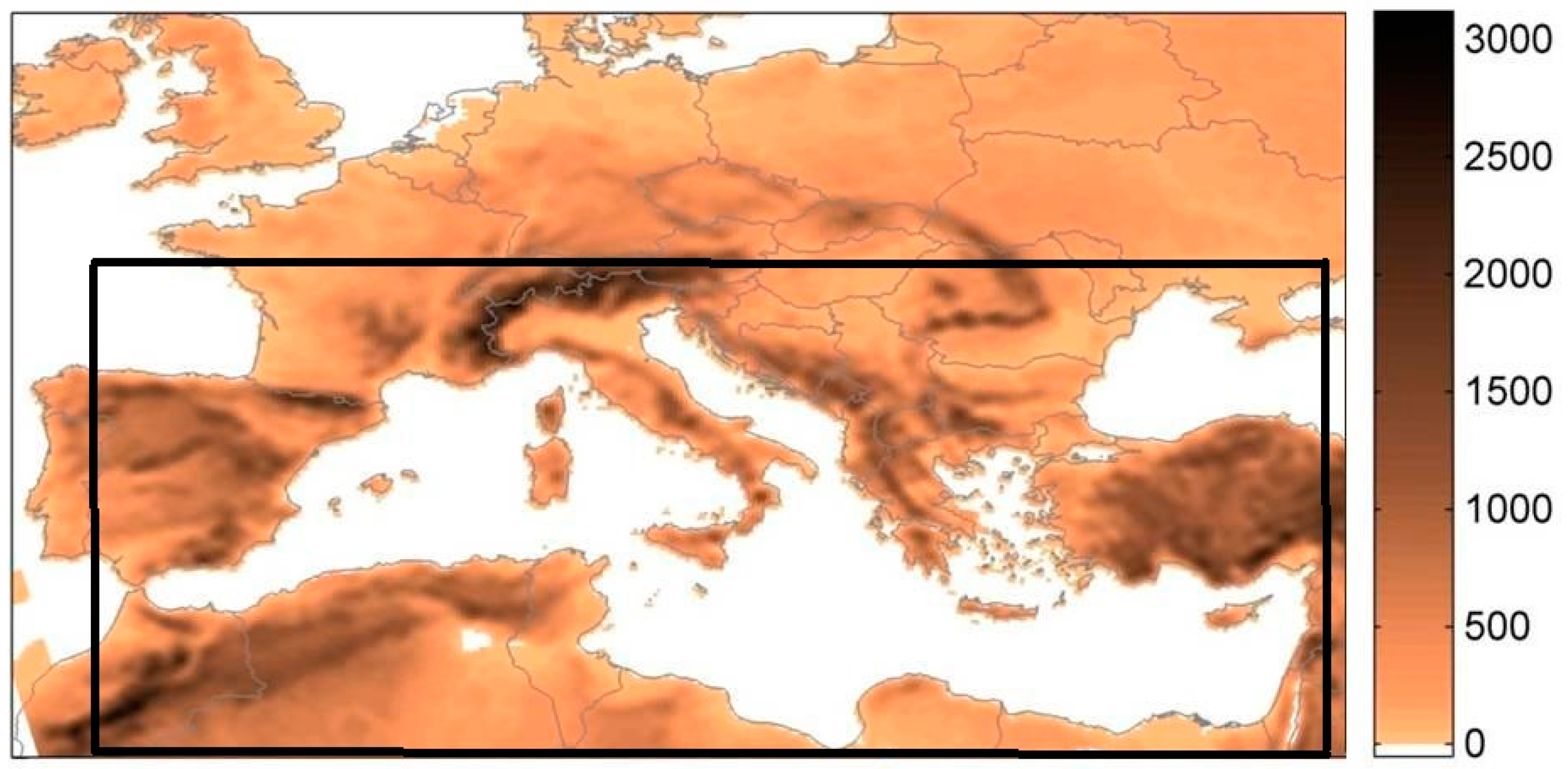

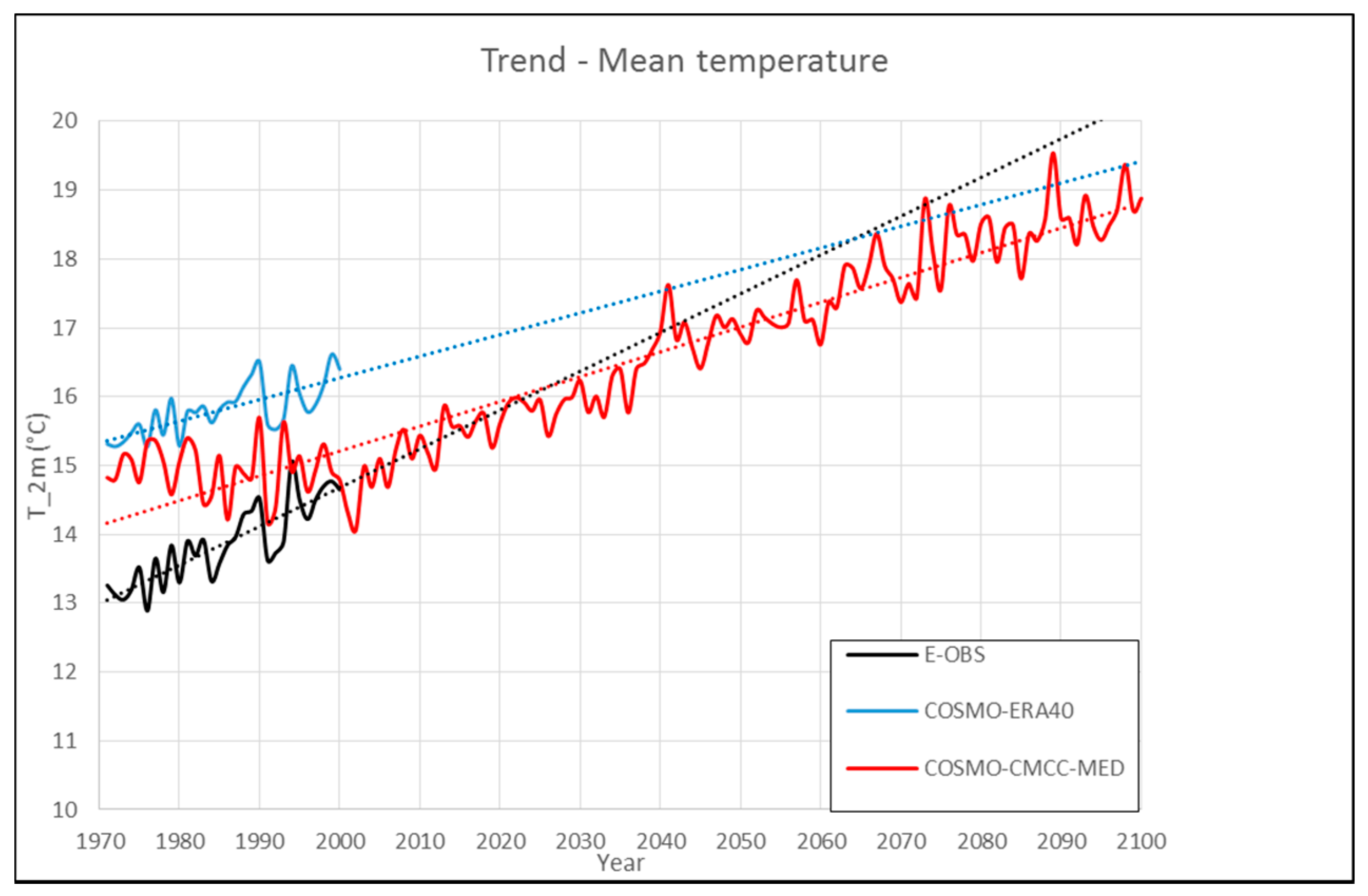
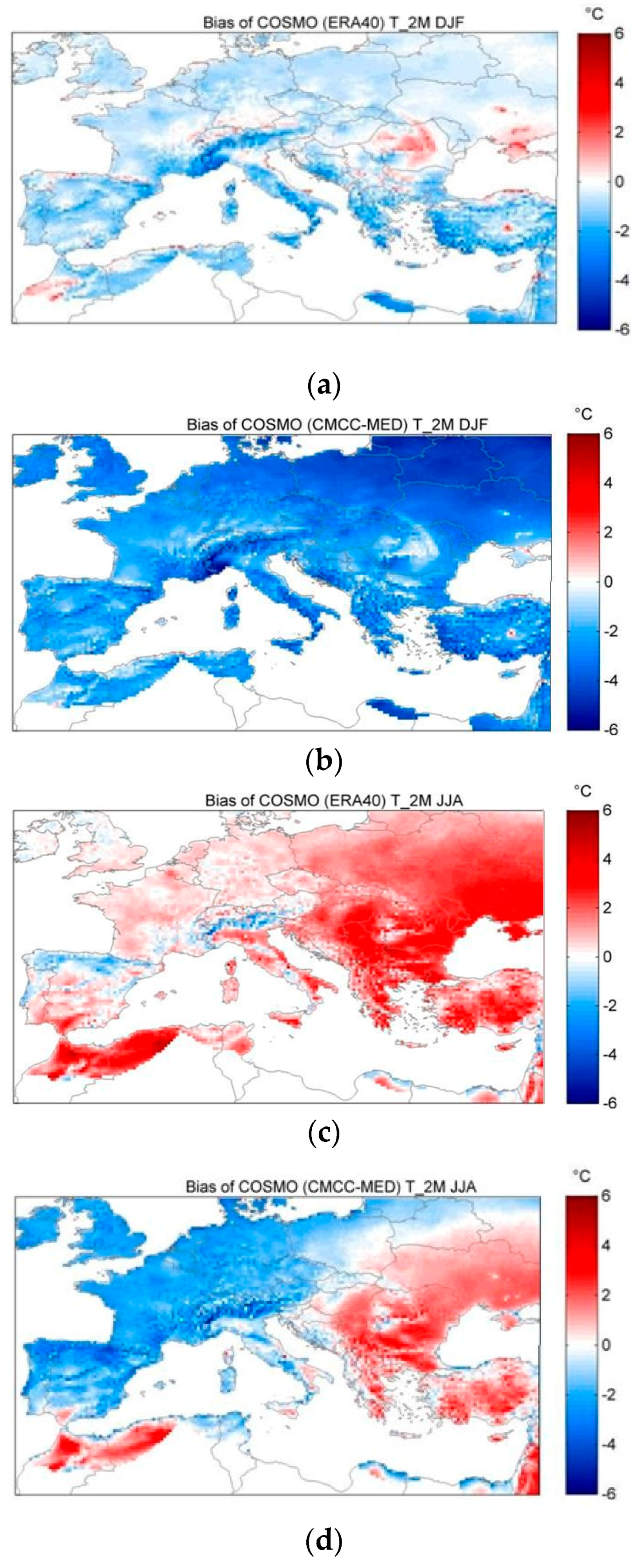
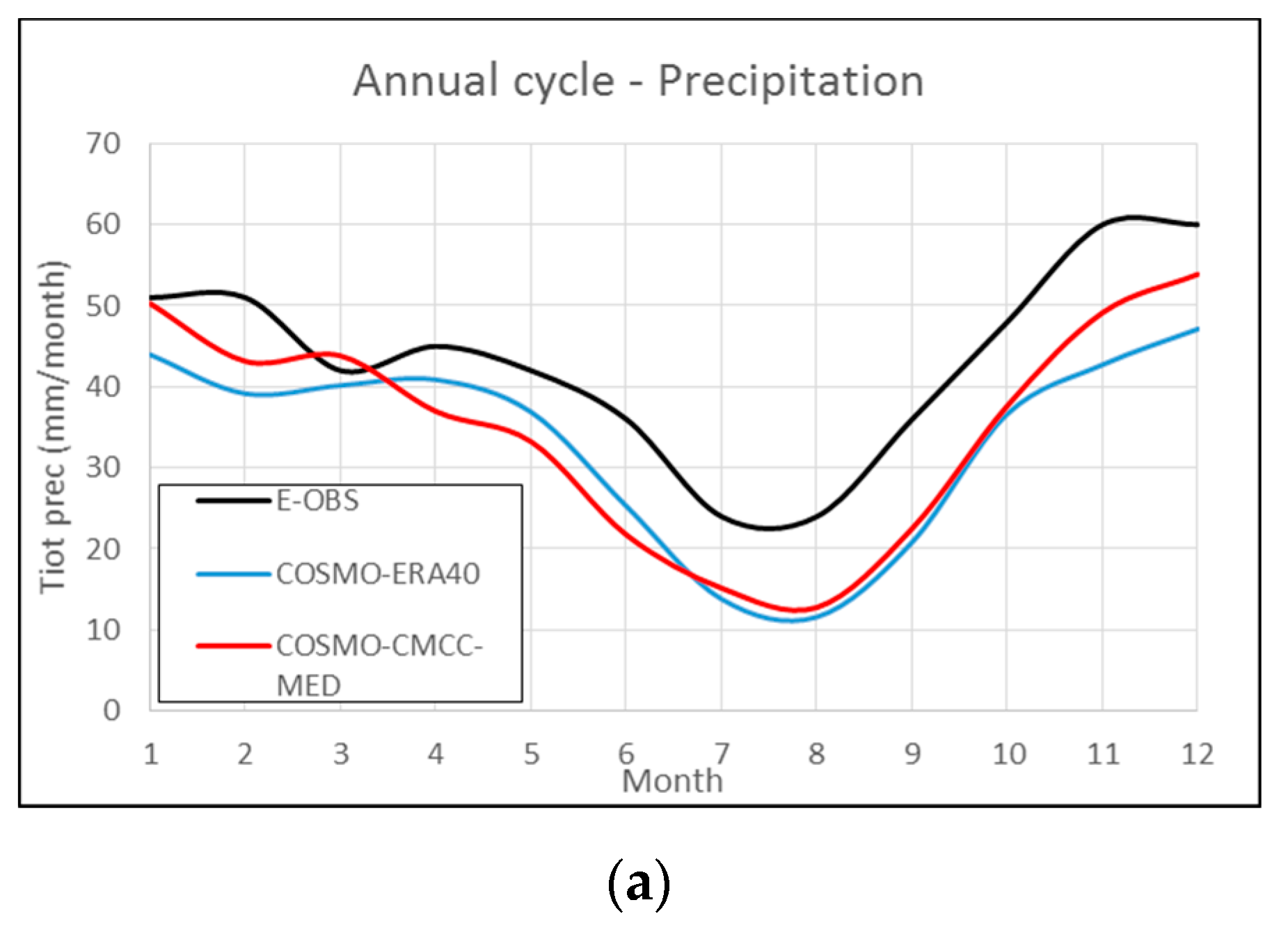
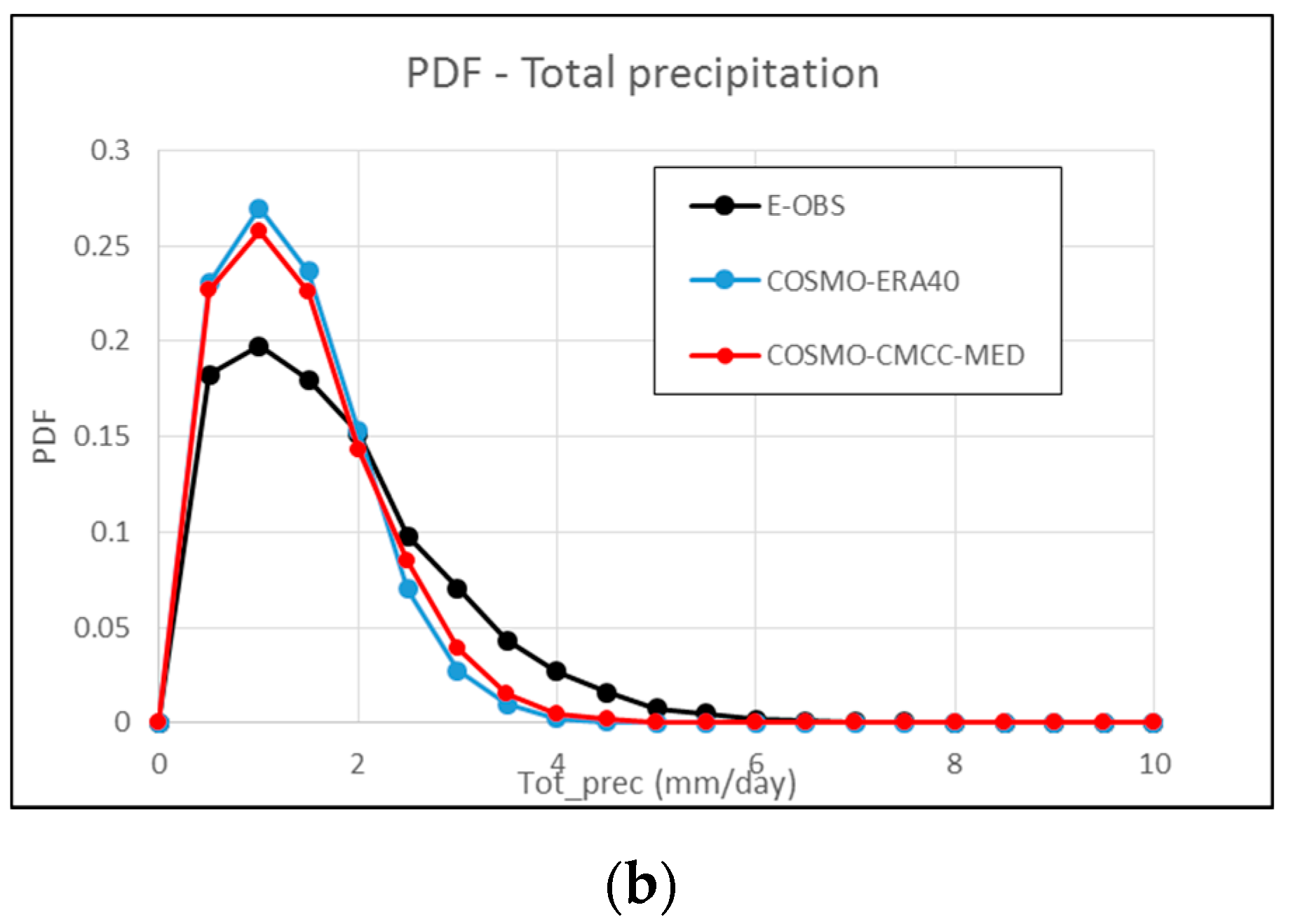
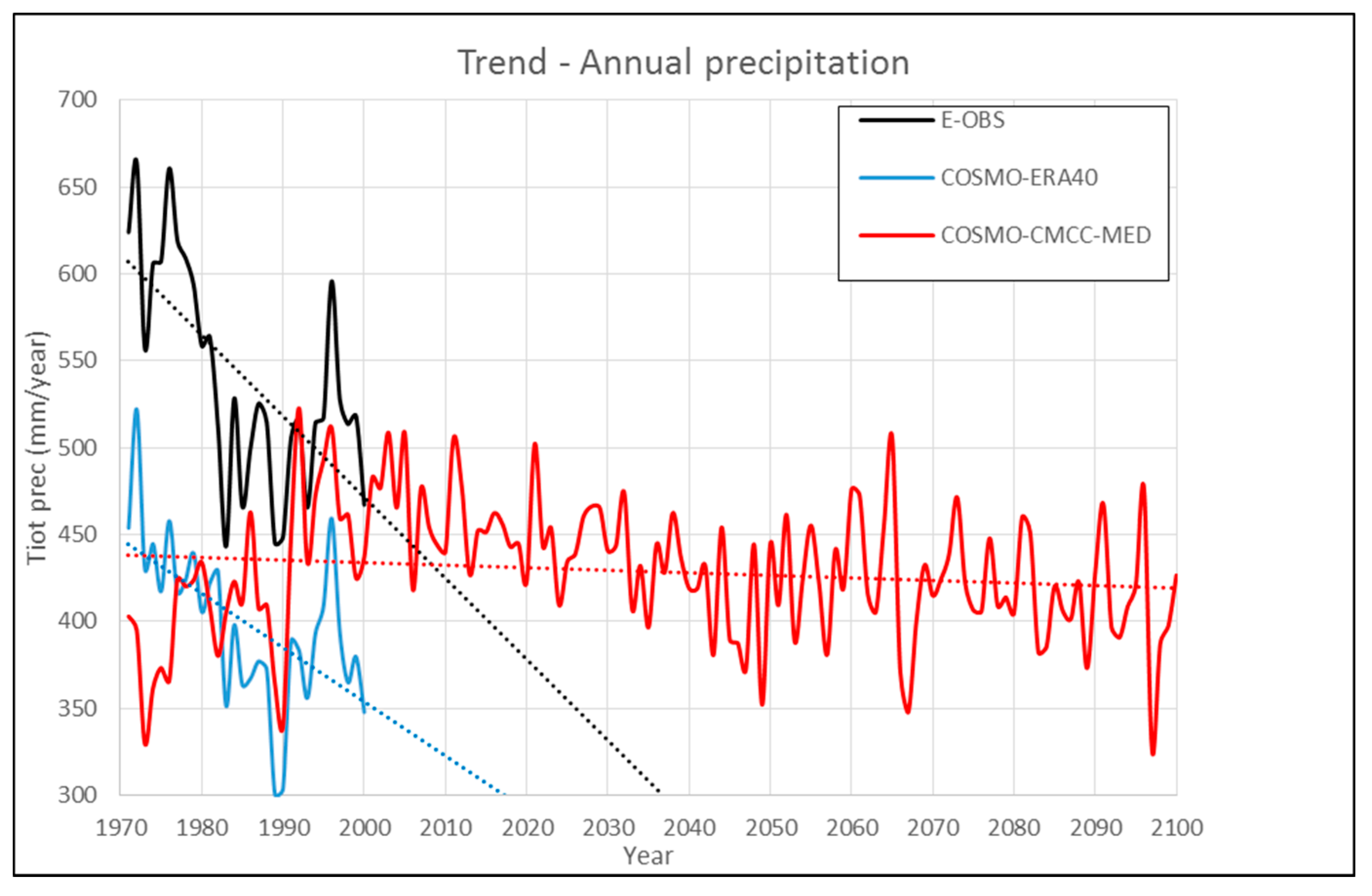
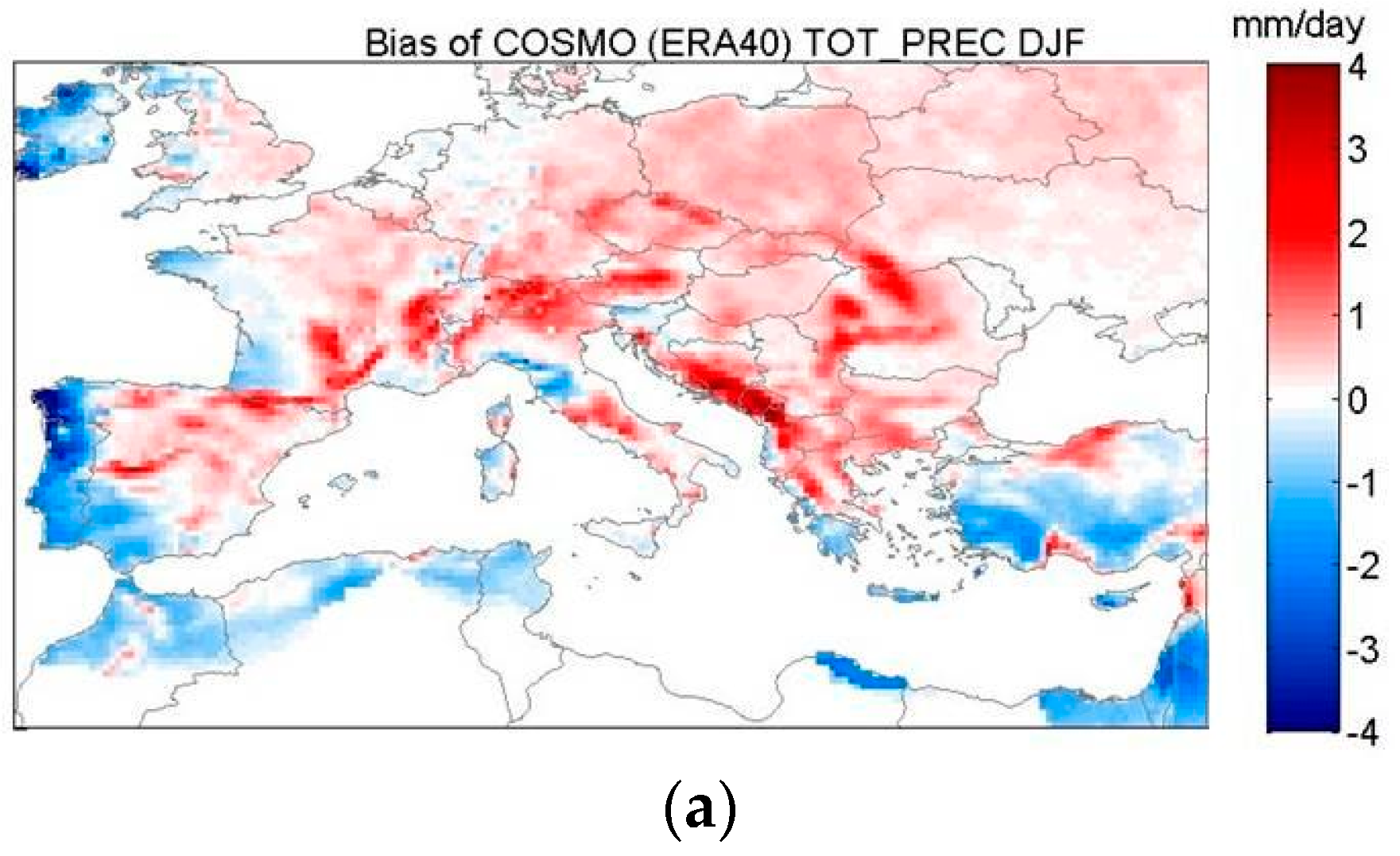
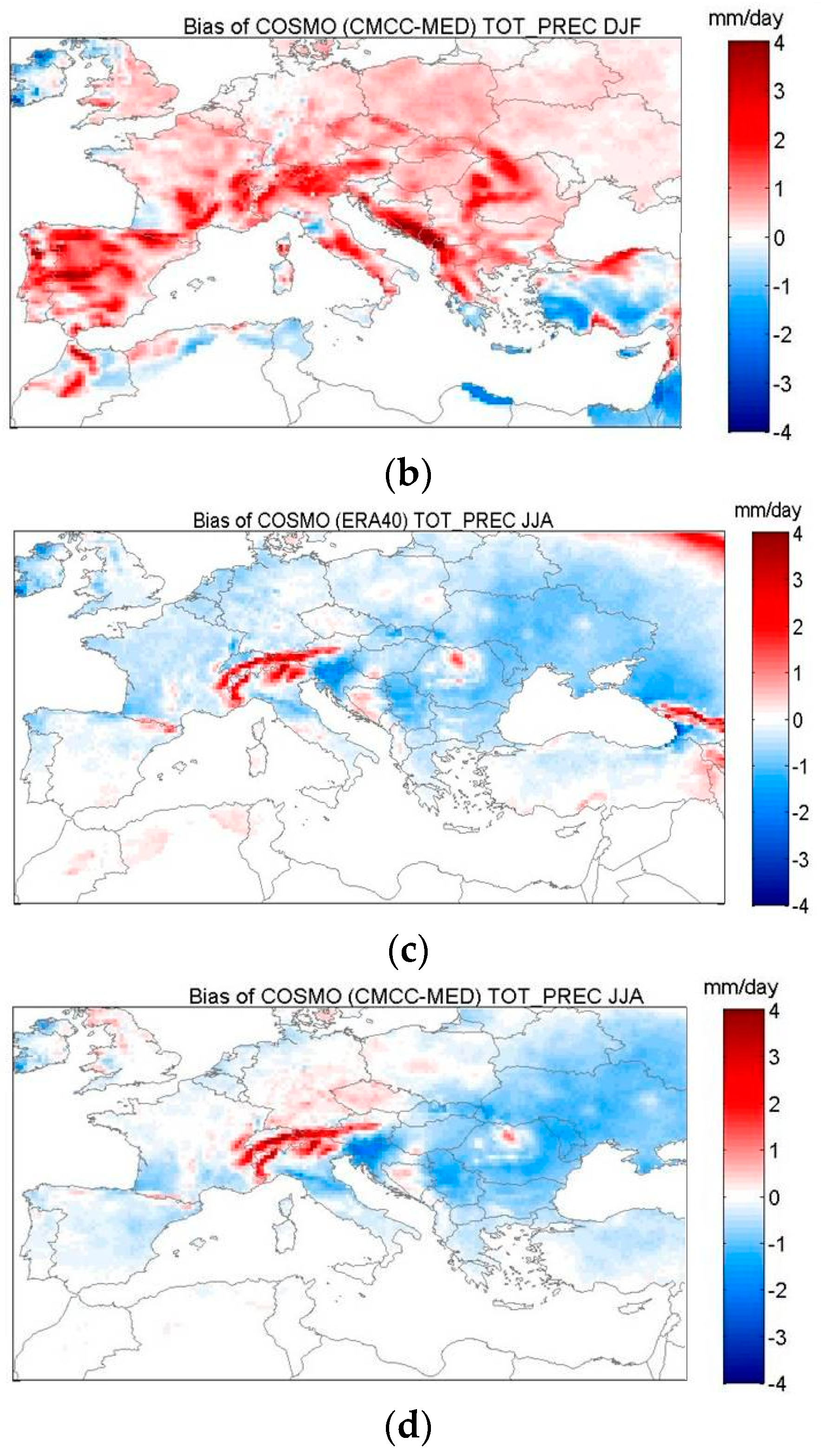

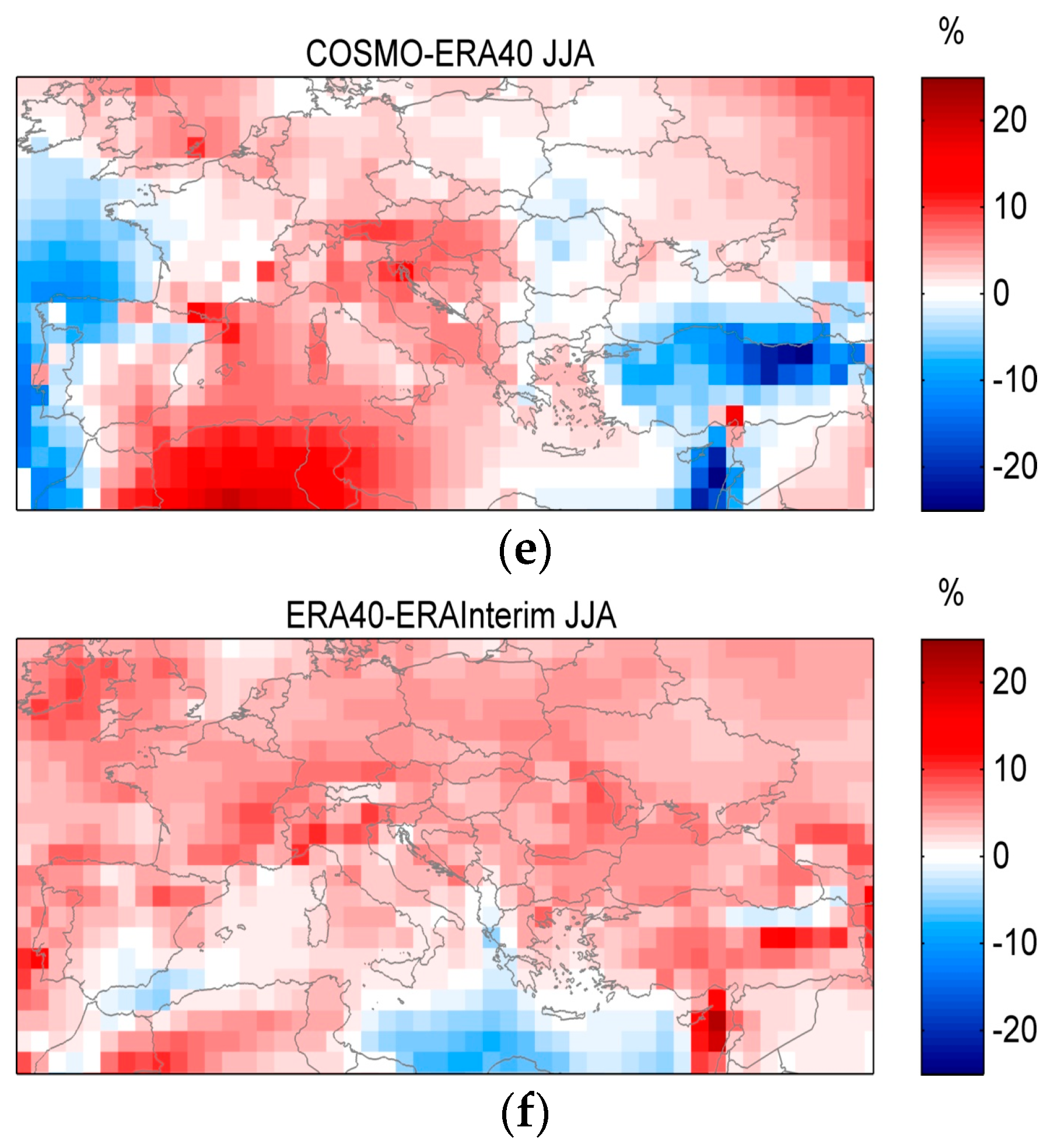
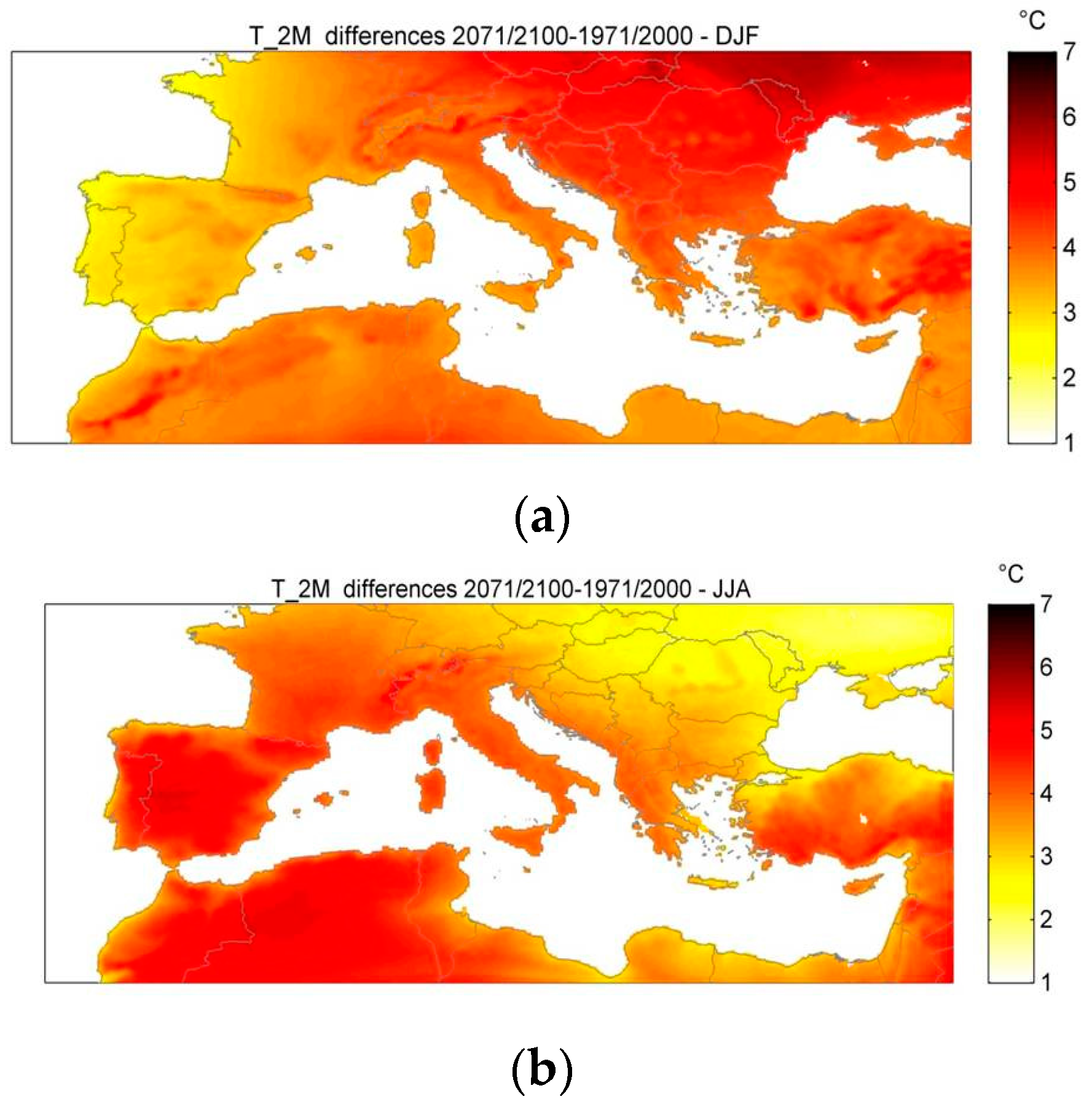
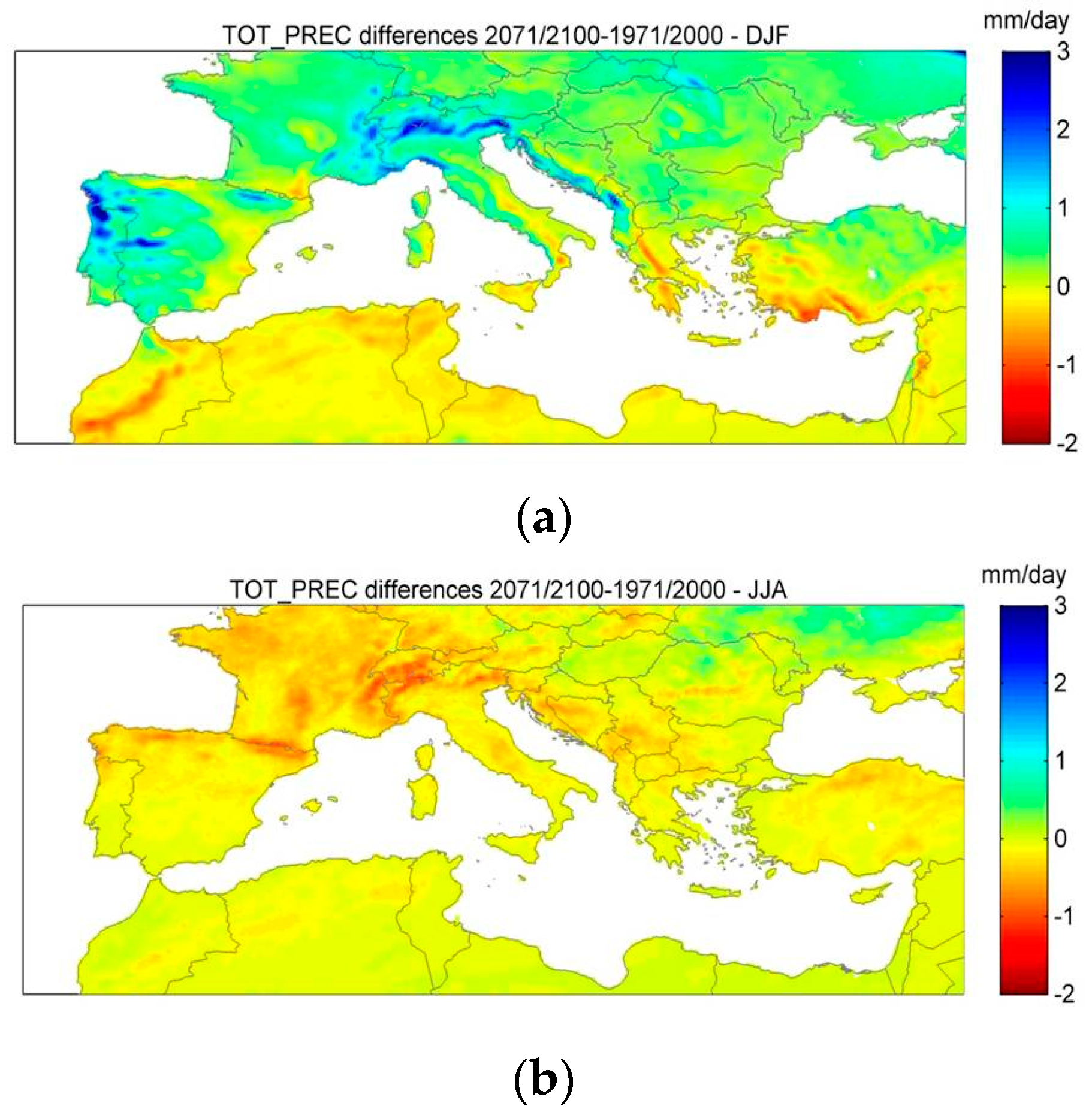
| Driving Data | ERA40 and CMCC-MED |
|---|---|
| Horizontal resolution | 0.125° (about 14 km) |
| Num. of grid points | 385 × 265 |
| Num. of vertical levels | 40 |
| Soil Scheme | TERRA-ML |
| Time step | 150 s |
| Melting processes | Yes |
| Convection Scheme | Tiedke |
| Freq. Radiation comput. | 1 h |
| Time integration | Runge-Kutta 3rd order |
| Freq. update B.C. | 6 h |
© 2017 by the authors. Licensee MDPI, Basel, Switzerland. This article is an open access article distributed under the terms and conditions of the Creative Commons Attribution (CC BY) license (http://creativecommons.org/licenses/by/4.0/).
Share and Cite
Edoardo, B.; Paola, M.; Myriam, M.; Lucia, Z.A. Numerical Simulation of the Period 1971–2100 over the Mediterranean Area with a Regional Model, Scenario SRES-A1B. Sustainability 2017, 9, 2192. https://doi.org/10.3390/su9122192
Edoardo B, Paola M, Myriam M, Lucia ZA. Numerical Simulation of the Period 1971–2100 over the Mediterranean Area with a Regional Model, Scenario SRES-A1B. Sustainability. 2017; 9(12):2192. https://doi.org/10.3390/su9122192
Chicago/Turabian StyleEdoardo, Bucchignani, Mercogliano Paola, Montesarchio Myriam, and Zollo Alessandra Lucia. 2017. "Numerical Simulation of the Period 1971–2100 over the Mediterranean Area with a Regional Model, Scenario SRES-A1B" Sustainability 9, no. 12: 2192. https://doi.org/10.3390/su9122192






